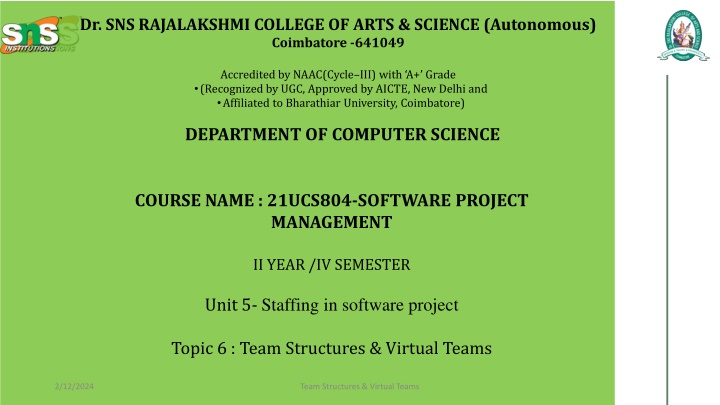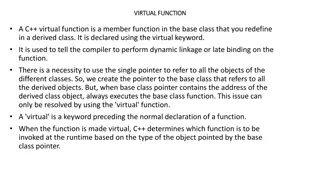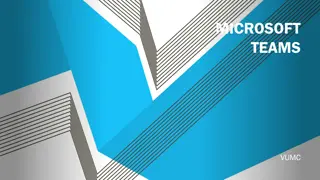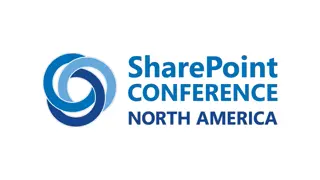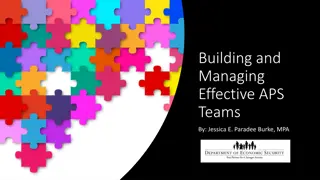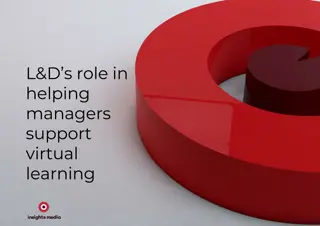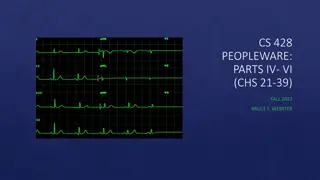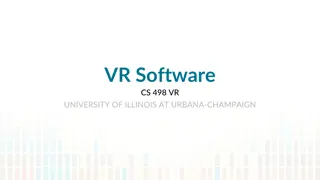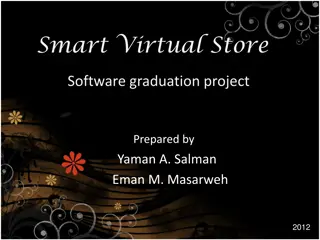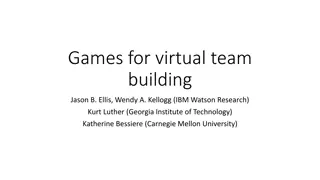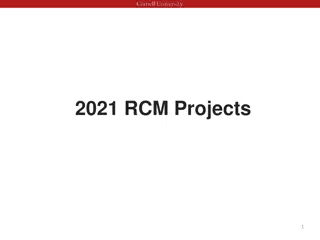Team Structures & Virtual Teams in Software Projects
Explore different team structures in software projects including functional teams, cross-functional teams, matrix teams, projectized teams, Scrum teams, hybrid teams, and the concept of virtual teams. Learn how virtual teams collaborate remotely and the challenges they face with communication, collaboration tools, and project management methodologies.
Download Presentation

Please find below an Image/Link to download the presentation.
The content on the website is provided AS IS for your information and personal use only. It may not be sold, licensed, or shared on other websites without obtaining consent from the author.If you encounter any issues during the download, it is possible that the publisher has removed the file from their server.
You are allowed to download the files provided on this website for personal or commercial use, subject to the condition that they are used lawfully. All files are the property of their respective owners.
The content on the website is provided AS IS for your information and personal use only. It may not be sold, licensed, or shared on other websites without obtaining consent from the author.
E N D
Presentation Transcript
Dr. SNS RAJALAKSHMI COLLEGE OF ARTS & SCIENCE (Autonomous) Coimbatore -641049 Accredited by NAAC(Cycle III) with A+ Grade (Recognized by UGC, Approved by AICTE, New Delhi and Affiliated to Bharathiar University, Coimbatore) DEPARTMENT OF COMPUTER SCIENCE COURSE NAME : 21UCS804-SOFTWARE PROJECT MANAGEMENT II YEAR /IV SEMESTER Unit 5- Staffing in software project Topic 6 : Team Structures & Virtual Teams 2/12/2024 Team Structures & Virtual Teams
Team Structures 1.Functional Teams: In this structure, team members are grouped based on their specialized skills or functions, such as developers, testers, designers, etc. Each functional team works on their specific part of the project and reports to a functional manager. 2.Cross-Functional Teams: These teams consist of members from different functional areas working together on a project. 3.Matrix Teams: Matrix structures combine elements of both functional and project-based structures. Team members have dual reporting relationships: they report to both a functional manager and a project manager. This structure allows for resource sharing and expertise from different functional areas. 2/12/2024 Team Structures & Virtual Teams
Team Structures 1.Projectized Teams: In a projectized structure, the entire organization is organized around projects. Team members are assigned to projects full-time and report directly to the project manager. This structure is often used in organizations where projects are the primary mode of work. 2.Scrum Teams: Scrum is an agile framework that emphasizes collaboration, flexibility, and iterative development. In Scrum, teams are self-organizing and cross-functional, consisting of a product owner, Scrum master, and development team. The team works in short iterations called sprints to deliver increments of the product. 3.Hybrid Teams: Some projects may require a combination of different team structures based on their specific needs. For example, a project might start with a functional team for initial planning and then transition to a projectized team for execution. 2/12/2024 Team Structures & Virtual Teams
Virtual Teams Virtual teams in software project management refer to teams of individuals who collaborate on software development projects remotely, often across different geographical locations. With the advancement of technology and the increasing globalization of the workforce, virtual teams have become more prevalent in the software industry. Managing virtual teams effectively requires careful consideration of various factors, including communication, collaboration tools, team dynamics, and project management methodologies. 2/12/2024 Team Structures & Virtual Teams
Virtual Teams 1.Communication: Effective communication is essential for virtual teams. Utilize various communication channels such as video conferencing, instant messaging, email, and project management tools to ensure clear and timely communication among team members. 2.Collaboration Tools: Utilize collaboration tools that facilitate virtual teamwork, such as project management software, version control systems, document sharing platforms, and virtual whiteboards. 3.Establish Clear Goals and Expectations: Ensure that team members have a clear understanding of project goals, objectives, timelines, and individual responsibilities. Regularly communicate expectations and provide feedback to keep everyone aligned. 4.Build Trust: Building trust among team members is crucial for virtual teams. Encourage open communication, transparency, and accountability to foster trust within the team. 2/12/2024 Team Structures & Virtual Teams
Decision Making 5. Cultural Sensitivity: Virtual teams often consist of members from diverse cultural backgrounds. Be sensitive to cultural differences and promote inclusivity and respect within the team. 6. Flexibility and Adaptability: Virtual teams may face challenges such as time zone differences, varying work schedules, and technological issues. Be flexible and adaptable in accommodating these challenges and finding solutions that work for everyone. 7. Effective Leadership: Strong leadership is essential for guiding and motivating virtual teams. Leaders should provide clear direction, support team members, facilitate communication, and resolve conflicts effectively. 8. Monitor Progress and Performance: Use project management tools and metrics to monitor project progress and team performance. Identify any potential bottlenecks or issues early on and take proactive measures to address them. 2/12/2024 Team Structures & Virtual Teams
ASSESSMENT 1. Explain about Team Structures & Virtual Teams ? 2/12/2024 Team Structures & Virtual Teams
References 1. Bob Hughes, Mike Cotterell and Rajib Mall: Software Project Management, McGraw Hill Education; 5 edition (1 July 2017), ISBN-10: 0071072748, ISBN-13: 9780071072748 2. A Kelkar, "Software Project Management A Concise Study", Third Edition, 2012, PHI Learning, ISBN-10: 8120347021, ISBN-13: 978-8120347021. Thank You 2/12/2024 Team Structures & Virtual Teams
